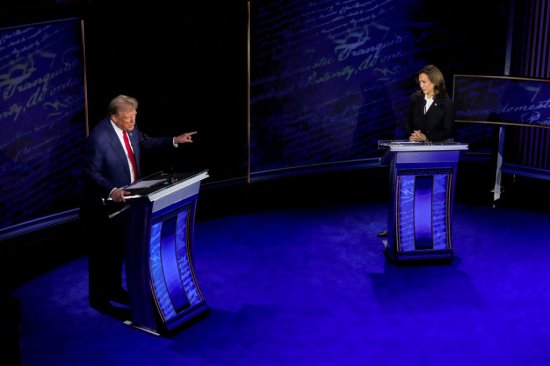
A look at Kamala Harris’ and Donald Trump’s plans for tackling housing affordability.
During Vice President Kamala Harris’ and former President Donald Trump’s debate, the first policy to come up was one that rarely receives airtime in presidential elections but affects Americans every day: housing affordability.
“Here’s the thing: we know that we have a shortage of homes and housing. And the cost of housing is too expensive for far too many people,” Harris said in one of the first sentences of her remarks Tuesday evening in Philadelphia.
Both candidates have talked about housing on the campaign trail. Harris released a recent 60-second ad on economic policy, focused primarily on housing and first-time homeownership, which outlines parts of her plan, including building new homes and providing down payment assistance. Trump, meanwhile, has vowed to reduce regulatory hurdles to building new homes, among other ideas.
[time-brightcove not-tgx=”true”]“We have never seen that before in a presidential debate between two major candidates, and certainly we’re hearing about housing affordability in elections at all levels, federal, state and local, far more than we have previously,” says Diane Yentel, President and CEO of the National Low Income Housing Coalition. “It’s a reflection both of how severe the housing affordability crisis has become and also of the organizing that’s putting pressure on politicians to respond.”
Read More: America Needs a New Approach on Affordable Housing. History Offers a Guide
According to Brian McCabe, Associate Professor of Sociology at Georgetown, housing affordability is not a new issue, particularly for the lowest income Americans renting without rental assistance or a voucher, and those utilizing public housing. But the current spotlight on the issue is at least in part due to affordability issues increasingly trickling upward to more middle-class Americans who are “politically really important for both parties.”
“This is hitting first time homebuyers that can’t get into the housing market. This is hitting middle class renters who are spending more than 50% of their income on rent,” says McCabe. “It’s not that there’s never been an affordability crisis before, but it’s now an affordability crisis that’s hitting a much broader set of Americans.”
Here’s a look at Harris’ and Trump’s plans for tackling housing affordability.
What Harris has proposed
Earlier this year, the Biden Administration announced a series of policy proposals that deployed a public-private approach focused on changing exclusionary zoning, expanding the financing options for affordable housing, and promoting the conversion of empty office space into apartments. Harris has since outlined further policies to address homeownership after becoming the Democratic nominee.
Harris’s plan largely focuses on the supply side of the problem, promising to “work with the private sector and home builders to… increase by 3 million homes by the end of my first term,” to address the housing shortage, she said in the debate.
Read More: The Biggest Moments From the First Debate Between Kamala Harris and Donald Trump
The federal government has “pretty limited muscle to actually move housing supply,” says McCabe, considering that regulatory burdens like zoning or building codes are usually at the local level.
Harris’ plan also includes expansion of the low-income housing tax credit (LIHTC) and additional tax incentives for builders to produce more “starter homes,” as well as creating a $40 billion tax credit to make affordable projects feasible for builders.
On the demand side, Harris has said she would provide $25,000 in down-payment assistance for first-time home buyers if elected.
What Trump has proposed
Trump did not mention housing during the debate on Tuesday, but he has previously addressed the issue during his campaign.
During a speech earlier this month to the Economic Club of New York, he promised to reduce regulations and open swaths of federal land for large-scale housing construction.“Regulation costs 30% of a new home, and we will open up portions of federal land for large-scale housing construction,” he said. “These zones will be ultra-low tax and ultra-low regulations—one of the great small business job creation programs.”
It’s not clear what types of regulations Trump wants to target, though taking a look at federal land may be a bipartisan solution: President Joe Biden called on federal agencies in July to “to assess surplus federal land that can be repurposed to build more affordable housing across the country.”
Read More: Meet the Friends Buying Houses Together
“Kamala Harris cannot be trusted to fix the housing affordability crisis—because she and Joe Biden caused it,” Karoline Leavitt, the Trump campaign’s national press secretary, told TIME in a statement over email when asked for details on Trump’s plan. “President Trump can be trusted to restore the American Dream because he has a real plan to defeat inflation, bring down mortgage rates, and make purchasing a home dramatically more affordable.”
Donald Trump has also tied housing costs to one of his signature issues: immigration. He said he would ban mortgages for undocumented immigrants, and that he will lower housing costs by “stop[ing] the unstainable [sic] invasion of illegal aliens which is driving up housing costs,” Leavitt said.
Trump implemented various housing measures during his first term as President, including establishing the “Preserving Community and Housing Choice” final rule, which repeals 2015 regulations implementing the statutory obligation to “affirmatively further fair housing.” During the height of the COVID-19 pandemic he also signed the evictions moratorium that prevented Americans from getting evicted.